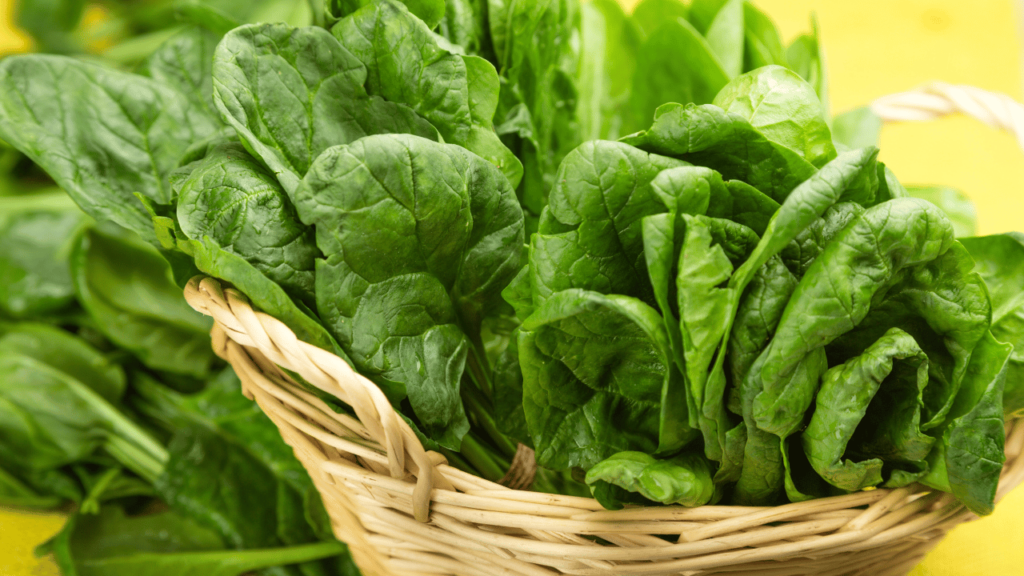Fresh Spinach
Fresh Spinach is a leafy green vegetable that is known for its nutritional benefits. It’s known for its vibrant green color and mild, slightly earthy flavor. Fresh Spinach is rich in vitamins A, C, and K, as well as iron, calcium, and folate. It can be enjoyed both raw in salads or cooked in various dishes like stir-fries, soups, and pastas. Spinach is a versatile and nutritious vegetable that can be a great addition to a balanced diet.

How Spinach Grow?
Spinach is typically grown from seeds. It thrives in cool weather conditions, so it’s often planted in early spring or late summer. The seeds are sown directly into the soil, about half an inch deep, and spaced apart to allow room for the plants to grow. Spinach prefers well-draining soil and requires regular watering to keep the soil moist. It usually takes around 6 to 8 weeks for the spinach plants to reach maturity and be ready for harvest. It’s a relatively easy vegetable to grow in home gardens, and it’s rewarding to enjoy fresh, homegrown spinach leaves.
Cultivation Of Spinach
Spinach is grown in many countries around the world. It is a versatile vegetable that can adapt to different climates and growing conditions. Some of the countries where spinach is commonly grown include the United States, China, India, Russia, and Spain. These countries have favorable conditions for spinach cultivation, such as cool temperatures and fertile soil. Spinach is also grown in many other countries, so it’s widely available in markets and enjoyed in various cuisines worldwide.

Types Of Spinach
There are different types of spinach that vary in their leaf shape, texture, and flavor. Here are some common types of spinach:
- Savoy Spinach: This type has dark green, crinkled leaves and a slightly bitter taste. It’s often used in cooked dishes and is known for its texture.
- Flat-Leaf Spinach: Also known as smooth-leaf spinach, this type has smooth, flat leaves. It has a milder flavor compared to savoy spinach and is commonly used in salads and sandwiches.
- Baby Spinach: Baby spinach refers to young spinach leaves that are harvested early. It has a tender texture and mild taste, making it popular for salads and smoothies.
- New Zealand Spinach: This variety is not technically spinach but is often used as a spinach substitute. It has thick, succulent leaves and can tolerate heat better than traditional spinach.
These are just a few examples, and there are other spinach varieties out there as well.
Benefits Of Spinach
Spinach offers a wide range of health benefits. It’s packed with essential nutrients like vitamins A, C, and K, as well as minerals like iron and calcium. Here are some benefits of spinach:
- Nutrient-rich: Spinach is a nutrient powerhouse, providing vitamins, minerals, and antioxidants that support overall health and well-being.
- Heart health: Spinach contains compounds that may help lower blood pressure and reduce the risk of heart disease.
- Eye health: Spinach is rich in antioxidants like lutein and zeaxanthin, which are beneficial for eye health and may reduce the risk of age-related macular degeneration.
- Bone health: The vitamin K in spinach plays a role in maintaining healthy bones and may help prevent osteoporosis.
- Digestive health: Spinach is high in fiber, which supports a healthy digestive system and can aid in digestion.
- Anti-inflammatory properties: Spinach contains anti-inflammatory compounds that may help reduce inflammation in the body.
These are just a few of the many benefits of adding spinach to your diet. It’s a versatile and nutritious vegetable that can be enjoyed in various dishes.
Dishes Of Spinach
Spinach is a versatile ingredient that is used in various dishes around the world. Here are some famous dishes that feature spinach:
- Palak Paneer (India): A popular Indian dish where spinach is cooked with spices and served with cubes of paneer cheese.
- Spanakopita (Greece): A traditional Greek pastry made with layers of phyllo dough filled with spinach, feta cheese, and herbs.
- Creamed Spinach (United States): A classic side dish in American cuisine, where spinach is cooked in a creamy sauce flavored with garlic and nutmeg.
- Saag (Pakistan): A flavorful Pakistani dish where spinach is cooked with spices, onions, and sometimes meat, such as chicken or lamb.
- Florentine Pizza (Italy): A pizza topped with spinach, cheese, and sometimes other ingredients like mushrooms or olives.
- Spinach Salad: A refreshing salad made with fresh spinach leaves, often combined with other ingredients like strawberries, nuts, and a tangy dressing.
These are just a few examples, and there are many more delicious dishes that feature spinach.
Side Effects Of Spinach
Spinach is generally safe to consume and has numerous health benefits. However, there are a few things to keep in mind regarding potential side effects:
- Kidney stones: Spinach contains oxalates, which can contribute to the formation of kidney stones in susceptible individuals. If you have a history of kidney stones, it’s recommended to moderate your spinach intake and consult with a healthcare professional.
- Interference with blood thinners: Spinach is high in vitamin K, which can interfere with blood thinning medications like warfarin. If you’re on blood thinners, it’s important to maintain consistent vitamin K intake and consult with your doctor about incorporating spinach into your diet.
- Allergic reactions: While rare, some individuals may be allergic to spinach. If you experience symptoms like itching, swelling, or difficulty breathing after consuming spinach, it’s important to seek medical attention.
Remember, these side effects are not common and most people can enjoy spinach as part of a healthy diet without any issues. If you have any concerns or specific health conditions, it’s always a good idea to consult with a healthcare professional.